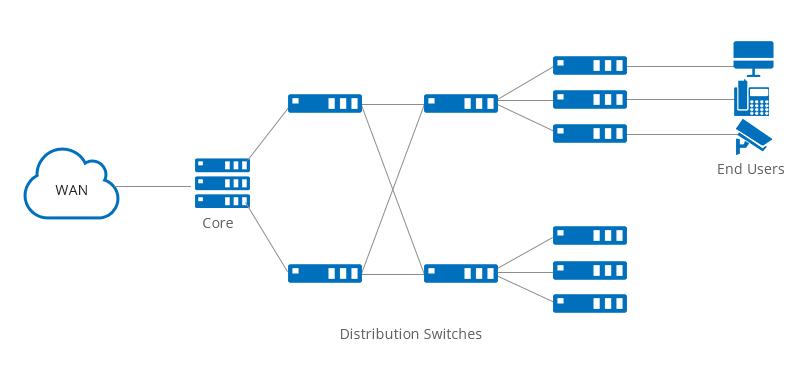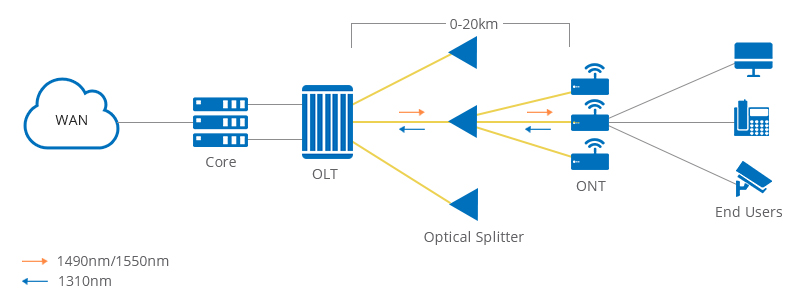Passive Optical LAN: Time to Shift Towards It
Over the years, copper-based LAN has been viewed as synonymous with LAN. However, development in the carrier networking technology has enabled fiber optics feasible in local area network applications. The fiber-based passive optical LAN shows its benefits when traditional LAN architecture is faced with the challenge of high bandwidth and high-density networks. Will passive optical LAN become the next-generation design for LAN? The outlook is positive.
What Is Passive Optical LAN?
Passive optical LAN, which is the acronym of passive optical local area network, can be also simplified into POL or POLAN. Seen from its name, apparently, there is something to do with passive optical network (PON). Passive optical LAN is built on the foundation of PON. Similar to any PON system, POL is a point-to-multipoint in-door network infrastructure with optical splitters to deliver data from a single point to multiple user endpoints and opting wavelength division multiplexing (WDM) technology to allow for bi-directional upstream and downstream communication.

Though passive optical LAN does not have as long a history as PON, in the local area network, it is considered to be the next generation infrastructure to replace the traditional copper-based LAN. Enterprises have been considering utilizing passive optical LANs for years but did not widely carry it out in the past few years because they think the copper-based network is enough for their needs. Nevertheless, taking the current network market and the future trends into account, passive optical LAN comes to its age.
Why Transition to Passive Optical LAN?
It is no accident that passive optical LAN is seen as the next generation of local area network design. The new trends of network development and the unique advantages of the technology itself hold pave the way for local area network design shifting towards POL. From the perspective of the current network background, there are some reasons that make the way for passive optical LAN.
Changing From Copper to Fiber
Changing from copper to fiber is the primary driver to the passive optical LAN. There has been fierce competition between copper cable companies and optical cable companies and the truth is brought out that access to the Internet via copper cables has reached its limitation. In an application deployed with Cat6 cables, speeds of 10Gbps can be reached with 55 meters’ distance. Even for Cat8, the new addition to the copper cable family, speeds of 10Gbps, 25Gbps and 40Gbps are limited within the reach of up to 30m. To handle 100G, 400G or even higher data rates in the future, fiber optics definitely wins in the battle.
Increase in IoT, Cloud and Video Business
As 5G and WiFi-6 hit the market, a revolution in IoT is taking place. Enterprises networks are urging more devices connected in larger places with more bandwidth. Meanwhile, more advanced technologies such as cloud also cause pressure on the LAN, the demand for network continues to grow as video streaming becomes the biggest driver of bandwidth increases, the traditional LAN can be a real issue.
Passive Optical LAN vs Traditional LAN: Advantages and Disadvantages
In a traditional copper-based LAN architecture, devices in the core layer link to the distribution layer switches and then the switches at the distribution layers connect down to the access layer switches at the communication closets. Copper cables are utilized from the closets to the users’ computers.

Passive optical LAN design changes the fundamental LAN architecture by replacing the copper cables with single mode fiber optic cables, thus it becomes an all-fiber connection with only a small number of copper cables connected to the endpoints. Further description of each component in a passive optical LAN system can be referred to in the next section.

Passive Optical LAN Advantages
Larger Scale and Reach
Compared with traditional LAN infrastructure, passive optical LAN decreases the amounts of cables and devices deployed in a network. The traditional LAN utilizes copper cables such as Cat6 in the architecture to transmit data while passive optical LAN uses the single mode fiber optic cables which are smaller, lighter, and less susceptible to interfaces, as the dominant medium, which means the distances covered in POL networks can be longer than the traditional one and the available space is larger, especially for hotel industries, which can spare space for more guest rooms.
Higher Efficiency and Security
Different from the traditional decentralized LAN, passive optical LAN design centralized intelligence and management. All services can be delivered across a single infrastructure, eliminating the need for multiple platforms to provide high-quality services to users. IT administrators will not need to manage and troubleshoot networks by checking the multiple devices on the spot, instead, less human intervention will decrease the possibility of human errors and improve efficiency and security.
Energy Saving and Environmentally Friendly
Because of the “passive” feature, it requires no power and emits less heat in passive optical LAN, thus it reduces or eliminates the needs for traditional distribution frames and telecommunications rooms, which also eliminates the need for air-conditioning. The transition from point-to-point architecture to point-to-multipoint enables less energy wasted by the copper cables, aggregation switches, or access switches, especially when long cables and PoE are used. What’s more, there is no need to frequently replace copper cables from Cat5 to Cat6 or Cat7 in POL. Once deployed and no matter if there are technology advancements in future years, passive optical LAN is always ready to accommodate these changes so as to enable investment protection.
Lower Installation and Operating Expenses
There is a general misunderstanding on costs that blocks the way to the adoption of passive optical LAN. If overlooking the total expenses but only focusing on the cables used in architecture, it is commonly acknowledged that a length of fiber optic cable costs higher than copper. Nevertheless, the truth is, what the installers need to consider include not only a length of cable but also other basic infrastructure in a certain scale as well as the operating expenses.
Passive Optical LAN Disadvantages
Less Possible to Deploy Immediately
On the one hand, though passive optical LAN offers great benefits to large enterprise deployment, the architecture can be hard to change in the short term since most enterprises invest heavily in copper networks. On the other hand, for small organizations, it is not a cost-effective solution as they will not use all the capacity of passive optical LAN.
Risk of Single Point of Failure
In passive optical LAN, 32 fibers are all converging into a single splitter module and the module is fed with only a single feeder fiber. It can be a difficult thing to isolate failure as all the shared fiber and splitter act as a single point of failure for all the users. If the fiber gets damaged, it may cause problems for all the users.
Of course, there is no such solution that completely performs better than another one. When designing a local area network solution, it is vital to take both advantages and disadvantages into account.
Primary Components of Passive Optical LAN
As mentioned, the building of a passive optical local area network requires less equipment. Removing the need for aggregation and access layer switches and communications closets, a typical passive optical LAN contains an optical line terminal (OLT), passive optical splitter and optical network terminal (ONT).
Optical Line Terminal (OLT)
The optical line terminal (OLT) deployed in passive optical LAN deals with both the upstream signals and downstream signals. It receives data from service providers by connecting to the Wide Area Network (WAN), and corporate resource services through the core router, and then sends the data to ONTs. Inversely, it also gets data from the ONTs and sends it to the providers. Typically an OLT port connects 32 ONTs.
Passive Optical Splitter
Passive optical splitter is a key component in passive optical LAN. Generally, there will be one or several fiber optic splitters deployed between the OLT and ONTs. These fiber optic splitters can be placed anywhere at the midspan of the optical network and equally distribute the optical signals to the end users without power supply. Fiber optic splitters are available in various split ratios, fiber type and package form factors. The most commonly used are PLC splitters.
Optical Network Terminal (ONT)
ONTs serve as the end user interfaces in the local area network. As most part of passive optical local area network is based on optical fibers, before connecting computers and other devices to the passive optical LAN, the optical signals should be transferred into electrical signals generally. ONTs and optical network units (ONUs) are added to convert single mode fiber optical signals to the RJ45 Ethernet interfaces connected to computers and other devices.
Except for the mentioned devices above, connectivity components are also needed like fiber patch cable, copper patch cable, fiber enclosures, connectors, fiber wall plate, pathway support materials and other cable management components. All these components make up for a high-performance passive optical local area network.
Passive Optical LAN Applications
For what applications would passive optical LAN show its superiority? Judging from the current trends, passive optical LAN has a tremendous opportunity to grow for many verticals including hotels, campus buildings, hospitals and large enterprises. Customers from various industries value different merits from POL. Overall, passive optical LAN is fit for these application scenarios features:
-
There is little space for network cabling. Especially for hotel industries which care about the space usage most, passive optical LAN takes the advantages in space and energy saving.
-
There is a need for converged and secure networks. For enterprises where video conferencing services, wireless access and monitoring services are all needed, passive optical LAN will converge all services across a single infrastructure in a protective way.
-
There is a need for easier network support through centralized management. In campus networks, multiple buildings can be connected to the main computer room with a simpler layout.
Conclusion
More and more enterprises are realizing the value of passive optical local area networks. For organizations that are looking for a network upgrading solution to achieve network bandwidth with security and reliability, the future-proof passive optical LAN solution is the best alternative to the traditional copper-based LAN.
You might be interested in
Email Address

-
PoE vs PoE+ vs PoE++ Switch: How to Choose?
Mar 16, 2023














